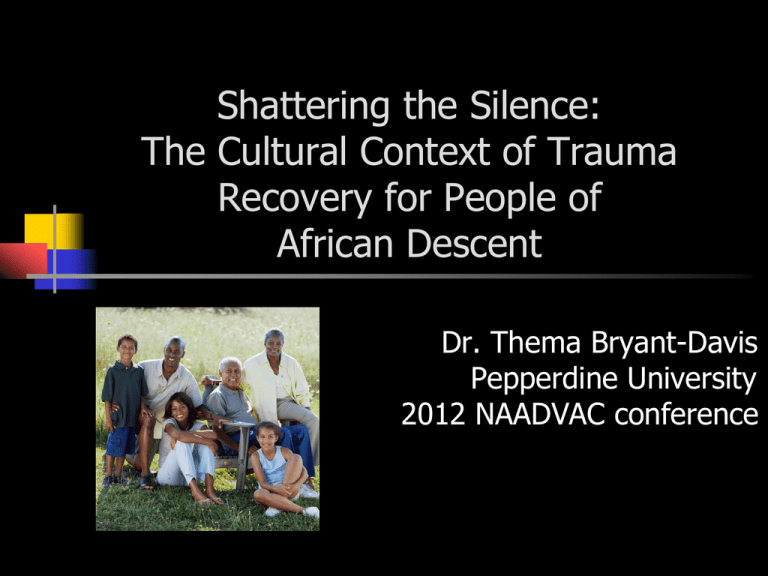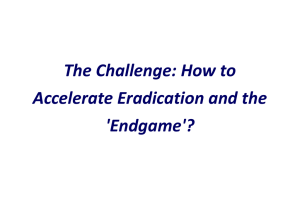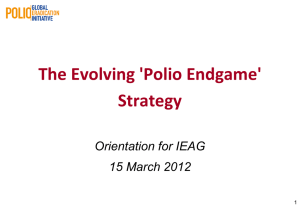Thema Bryant-Davis: Keynote address
advertisement

Shattering the Silence: The Cultural Context of Trauma Recovery for People of African Descent Dr. Thema Bryant-Davis Pepperdine University 2012 NAADVAC conference Moving from the margins to the center Acknowledgements This literature review was made possible in part by the Robert Wood Johnson Foundation’s New Connections Initiative. Acknowledgements are also given to Dr. Bryant-Davis’ graduate research assistants Sheila Shervey, Heewoon Chung, and Shaquita Tillman. Intimate Partner Violence Definition A pattern of emotional, verbal, physical/and or sexual abuse of one intimate partner by another for the purpose of obtaining and maintaining power and control. Persons may be dating, partnered, married, or previously in an intimate relationship. Prevalence and Disproportionality Women of African descent living in the United States are disproportionately victimized by intimate partners and are additionally more likely to experience more severe levels of partner abuse. This is the case for adult intimate partners and adolescent dating partners Culture versus Context IPV prevalence in contrast African Americans are disproportionately represented among victims of IPV African American women experience IPV at a rate 35% higher than that of White women and approximately 2.5 times that of women of other races Intimate partner violence also takes more violent forms against African American women than against White women Homicide by an intimate partner is the leading cause of death among African American women ages 15–34 Women who are African American, young, poor, have children under the age of 12, and who reside in urban areas are the most frequent victims Background West, (Kilpatrick et al., 2007; Siegel & Williams, 2003; Williams, & Siegel, 2000) Lifetime prevalence of forcible rape in US is 16.1% African American women are at equal or increased risk for sexual assault One study found a 50% higher prevalence rate than the rate for Caucasian and Hispanic women 30-75% of African American survivors of child and adolescent sexual abuse experience revictimization Effects Somatic Spiritual Cognitive Behavioral Relational Emotional Sexual Physical Psychosocial Consequences (Banyard, Williams, & Siegel, 2001; Coker et al., 2000; Wilsnack, Wilsnack, Kristjanson, Vogeltanz-Holm, & Harris, 2004; Bryant-Davis, 2005) Sexual assault increases vulnerability for a range of mental health conditions Sexual violations impact cognitive, affective, and social domains of functioning Historically, African Americans have underutilized mental health services Risk Factors for Victims Being female Exposed to IPV as a child Education Income Community disorder Expanding Our Vision When socioeconomic status is accounted for, ethnic differences in prevalence rates are reduced or eliminated. Income alone is not the answer however. A study with middle class Black and White women found that the Black women had higher rates of IPV. Less research has looked specifically at educational attainment. Research Findings on Risk Participants who indicated that they had no income from earnings for the last year were more likely to experience verbal abuse. Participants who indicated they had less education were more likely to experience forced isolation from family and friends as well as physical abuse. Those who live in unsafe neighborhoods were more vulnerable to physical and verbal abuse. African American women who were older reported more verbal abuse From Fragile Families Data (Princeton University) Risk factors for perpetrators Unemployment or underemployment Subscribe to strict gender roles Have not graduated from high school Substance abuse (especially alcohol) Grew up in an environment where they were exposed to partner abuse Considerations Superwoman concept Refusal to work Community response to public violations Minimization of victimization – mutual abuse controversy Cultural Barriers and Resources - Intersectionality Race; Inter-racial couples Gender Disability SES Migration Status Religion/Spirituality Sexual Orientation Coping Strategies Social Support Religiosity Substance abuse Expressive Arts Avoidance/Busyness Minimize/Deny Resilience in the community (Glass et al., 2007; Meadows et al., 2005; Yick, 2008; Alim et al., 2008) Religiosity and Spirituality Sense of connectedness to a higher being and outward expression of spiritual beliefs Survivors of sexual assault document a variety of benefits that enhance psychological functioning Protective against psychopathology Social Support Reliance on relationships with others in the face of adversity. Protective against posttraumatic distress and suicidality Motivates steps toward positive transformation Reflection Social support serves a protective role for trauma survivors for survivors of sexual assault, IPV, and community violence Religiosity gives mixed findings due to some survivor’s use of negative religious coping and/or greater need for religious involvement for those who are experiencing more symptoms Trauma and Recovery (Bonanno, 2004; Bryant-Davis, 2005; Yick, 2008) Humans demonstrate the capacity to thrive in spite of experiencing trauma Many African American women endorse use of social support and religiosity to cope with life stressors Community Response Socio-historical context of intergenerational trauma Religious Hip hop Community attitudes (Perception of victims as “weak”) Therapeutic Interventions Safety Planning Strengths based Solution focused; Narrative Cognitive Behavioral Individual, Family, Group Faith-based Feminist Therapy; Expressive Arts Interventions with children exposed to IPV Court intervention; restorative justice models Additional challenges for African and Caribbean Immigrants Lack of social support Uncertainty about resources Fear and distrust of government institutions Language barriers Multiple traumas Family and community reliance Rigid Gender roles and expectations Victims of Human Trafficking Community and family normalizing Prevention Interdisciplinary approach Early intervention: dating violence Modeling of healthy relationships Coping strategies to address life stressors including societal traumas What we still need to know Culturally informed modifications of “evidence-based therapy” How to address barriers in a society where “race matters” – social justice informed advocacy, prevention, and intervention strategies Experience of intersectionality – gay and lesbian African Americans; African Americans with disabilities; inter-racial couples Barriers to gaining more information Not a priority due to devalued status Disregard for qualitative research Bi-directional distrust between institutions and community Lack of funding Implications Need for continuing training for counselors on cultural and religious sensitivity & strengths based, multi-cultural feminist orientation Therapist should assess for social support and religiosity Interventions should include strategies for enhancing social support, as well as adoption of healthy coping strategies Selected References Violence in the lives of Black women: Battered, Black and Blue. Edited by Carolyn West Thriving in the wake of trauma: A multicultural guide by Thema BryantDavis Surviving the Silence: Black women’s stories of rape by Charlotte Pierce Baker










